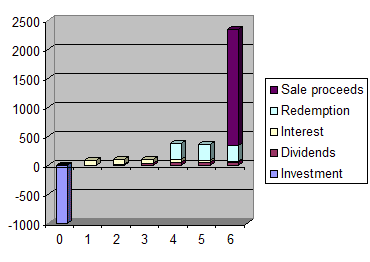Raising Development Capital
Businesses with potential for rapid growth often find that taking on an investment from a private equity fund or private investors, together with some bank debt, enables them to accelerate their growth plans. Whilst the founder’s ownership is diluted, they own a reduced share of a larger and more successful business. The purpose of this guide is to explain the process of raising development capital.
The private equity market has polarised in recent years into funds looking to back leveraged buy-outs and funds looking to invest venture capital into businesses with good growth prospects. It is the latter funds with which we are interested in this Guide. The venture capital funds are interested in taking a minority share of ownership (in the form of ordinary shares and preference shares) in return for their investment, and expect to make a compound rate of return of approximately 25-40% over the life of the investment, depending on the risk profile. Their return is normally earned largely through the eventual sale of their investment, either when they and the founders sell the entire business together, or when the founders buy-out the venture capitalist. The venture capital may receive dividends prior to a sale, and may receive some of their principal back via redemption of preference shares (see below).
The investment by the venture capitalist is normally in a mix of ordinary shares (these are the shares with voting power, dividend rights and the right to a share of proceeds on sale) and preference shares (or loan stock) which are effectively long term loans, with pre-determined repayment dates and interest rights. The example set out below demonstrates the use of the two different types of shares.
The venture capitalist will normally require a seat on the Board (or at least the right to attend Board meetings) to monitor their investment but will not interfere with the day-to-day running of the business if the business is going well. They will have rights that will appear disproportionate to the minority percentage shareholding, relating to share transfers, Board changes etc but this is because they are relying on management to run the business effectively, and therefore need to be able to take remedial action if there are problems in the business.
To attract venture capital it is necessary to prepare a Business Plan and financial projections, setting out the strategy for the business, the reasons for raising funds and the projected future cash flow to service the new funds. It is important to select venture capitalists that are interested in your company’s sector and your size of business. The British Venture Capital Association’s website is a good source of information (www.bvca.co.uk).
If some bank debt (loans, overdrafts, invoice discounting) can be obtained to reduce the need for venture capital this will help to reduce the shareholder dilution effect. For businesses that have been trading for less than 5 years and whose activities qualify, the DTI’s Small Firm Loan Guarantee Scheme can be a valuable source of up to £250,000 of loans (http://www.dti.gov.uk/bbf/small-business).

The venture capitalist will review the Business Plan and projections, visit the business and, if they are interested, issue an indicative offer, setting out the main terms of the investment, and conditions. If outline terms are agreed they proceed to due diligence, when a firm of accountants and lawyers will subject the business to scrutiny. They will then issue an Investment Agreement, which your lawyers will negotiate with their lawyers. The whole process takes approximately 3-6 months.
An example of the life cycle of a typical venture capital investment is as follows. In this example, the VC is investing £1 million for a 20% stake in the business, thereby valuing the business at £4 million ‘pre-money’. The investment is in the form of £200,000 of ordinary shares (with no fixed dividend rights, and ranking equally with the founders 80% shareholding) and £800,000 of loan stock, with 10% fixed interest and repayment (‘redemption’) terms of 3 years, starting in the third year. Sometimes the VC looks for a ‘participating’ dividend (pre-determined share of profits). In this example the company pays some small dividends on the ordinary shares and is sold for £10 million after 6 years, yielding £2 million of proceeds for the VC, and £8 million for the founder. The outflows and inflows for the VC over the lifetime of the investment are therefore as follows:
Whilst the above example is rather simplistic, it demonstrates that the VC is primarily interested in the prospects for profit growth and exit, given that profits generate cash for dividends, interest and loan repayment, and are the key to a business’s value. To the extent a business owner can demonstrate good, tangible prospects for profit growth and can identify future potential purchasers, this will help their negotiating position. It is also useful to have more than one VC interested, to create some negotiating leverage.
For more information on raising development capital, contact:
Jeremy Cole, partner, Cole Associates on 0161 832 9945,
jeremycole@cole-group.co.uk.